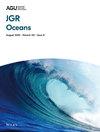The Great Calcite Belt (GCB) is a region of elevated particulate inorganic carbon (PIC) generated by coccolithophore growth that spans the subantarctic Southern Ocean. The GCB is thought to play an important role in the global carbon cycle. Coccolithophores, however, are sensitive to multiple climate-related environmental factors. To understand these controls on Southern Ocean coccolithophores comprising the GCB, we explore its major bottom-up and top-down processes using the Community Earth System Model (CESM). We find that coccolithophore biomass accumulates where both macronutrients and iron are available at concentrations greater than ∼50% of their half-saturation constants, and temperature is more limiting than both light and nutrients. Coccolithophore biomass is decoupled from growth rates due to top-down control. At higher temperatures and lower latitudes, microzooplankton grazing outpaces coccolithophore growth. This occurs because the temperature dependence of grazing is parameterized with an exponential (Q10) function, whereas coccolithophore growth is parameterized with a power function; these temperature curves diverge at higher temperatures. While the extent of the GCB is primarily controlled by temperature, its magnitude is most strongly controlled by environmental factors affecting iron concentrations. Our results suggest that (a) the temperature relationships for both coccolithophore growth and its loss terms are critical for resolving a GCB in CESM, and (b) the spatial extent of Southern Ocean coccolithophores may be sensitive to continued increases in sea surface temperatures.


